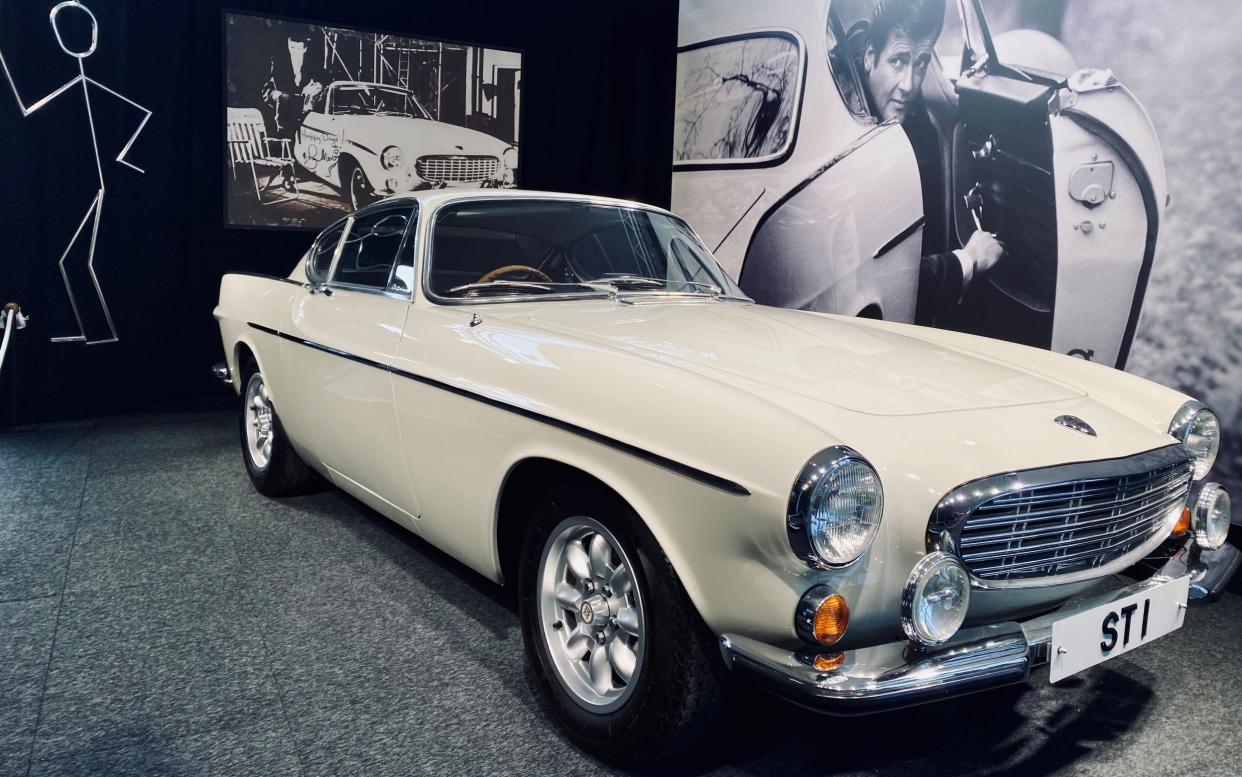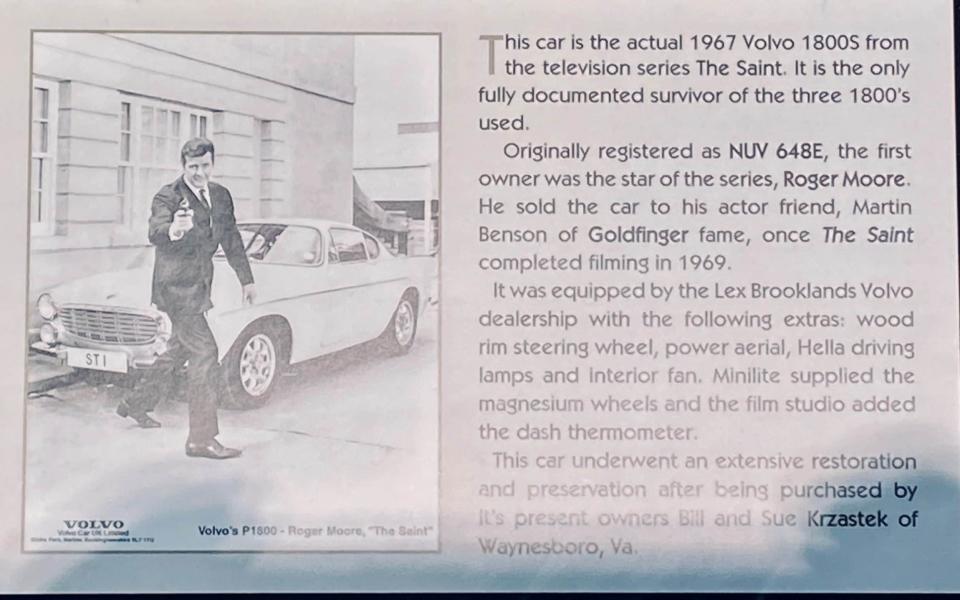The car that seduced Roger Moore: Volvo P1800 at 60

This is a very special year for admirers of an enduring classic car and equally vintage TV series. Sixty years ago, Simon Templar – the debonair, besuited adventurer with a slicked-back barnet who seemingly resolved the world’s troubles without putting a hair out of place – drove onto our screens in his gleaming white Volvo P1800 sports car.
So, we’re celebrating not only the 60th anniversary of The Saint, which ran between 1962 and 1969, but the arrival of the sleek and reliably robust offering from Volvo. Right-hand drive P1800s arrived in the UK in 1962, only 12 months after the first left-hand drive model appeared in Sweden.
You would have thought that having your car showcased each week on TV with popular actor Roger Moore behind the wheel was something car manufacturers would jump at. Surprisingly, that wasn’t the case 60 years ago.
Despite the obvious marketing benefits, companies including Jaguar, Vauxhall and Ford declined the chance to provide a car for filming purposes while Mercedes, allegedly, offered the use of a vehicle for just one day. Volvo, meanwhile, had the foresight to realise that having its new P1800 appear in more than 100 episodes on prime-time television was a golden opportunity.
A “comfortable sports car with timeless design” was how Volvo’s then CEO, Gunnar Engellau, described the P1800 when it was launched in Sweden during May 1961. A year later, the model – originally assembled by Midland-based Jensen Motors before manufacturing moved to Sweden – arrived in the UK, although its main intended market was the USA.

Some critics, however, thought the company was on a hiding to nothing considering Volvo’s previous attempt to break into this sector of the US market was a dismal failure. The roadster-styled Volvo Sport (project name P1900) with its glass-fibre body and 1,414cc engine failed to seduce car buyers and, ultimately, only 68 were sold.
The company’s executives had high hopes for the P1800, however. “Volvo needed a car which would entice people into the showroom. Then, it was hoped that the sales staff would convince would-be customers to buy the company’s volume car, the Volvo Amazon,” says Kenneth Collander, who, along with fellow enthusiast Mats Westerman, has written a three-volume history of the P1800 (currently only available in Swedish).
Between 1960 and 1973, nearly 48,000 cars – including just over 8,000 shooting brake versions – rolled off the assembly line and it soon attracted its fair share of famous faces. Among the celebrity owners were Swedish royalty, Raquel Welch, Leeds United FC captain Billy Bremner and British actors Gerald Harper and, of course, Roger Moore. So impressed was he with driving the vehicle in The Saint, he bought his own, in January 1967. Upon his death in 2017, the car was donated to the Volvo Museum in Gothenburg.

The original sales brochure boasted that the P1800, with its 100hp (98.6bhp) engine and fully synchromesh-equipped gearbox, was a car which attracted attention through the “sheer beauty of its handsome lines and its effortless sparkling performance both in dense city traffic and on the open highway”.
Originally offered in three colours – white with red trim, red with white trim and grey with red trim – the car was perceived as comfortable and stable and therefore highly suitable for fast, long journeys. “Volvo’s aim was to give the car a timeless shape. Overall, it was considered a beautiful creation – solid construction with fine details. The brakes and steering were praised, too,” says Collander, 50, who lives in Falun, north of Stockholm.
At its launch, various motoring journalists test drove the car with the lion’s share extremely positive. One wrote: “Volvo’s sports car is an excellent alternative for those who want a fast, comfortable, safe and easy-to-drive car at a good price and with low operating costs.”
However, as with most launches, there are teething problems and the P1800 was no exception. In October 1961, reports were received from Volvo’s technical and sales staff in the United States regarding the four-cylinder, 1,778cc coupé.
“Some said that the rear axle made too much noise and that the disc brakes looked cheap,” says Collander. “Criticism was also reported regarding the tightness of the body, with leaks at the doors, windows and fresh air intake. Externally, the quality of the painting was questioned, too, but these issues were subsequently resolved,” adds Collander, who owns reputedly the oldest-running, serial-produced right-hand drive 1800.
“The first right-hand-drive example produced was serial number 3001 and mine is 3004,” he says. “It was made in March 1962 and I saved it for restoration in 2006. The car was in London so I travelled on the freight ferry from Gothenburg to the UK and brought it to Sweden.

“I’ve been replacing some rusted steel sections and there is more work to do to bring it back to its former glory. But I’ve reached the view that it deserves to return to the UK’s right-hand drive market where it belongs. Being a Jensen Motors-produced car and among the first right-hand drives, I think there will be plenty of people interested in buying it and restoring it to full pristine condition.”
So Collander – who owns two other 1800s, including a blue 1972 automatic – is open to offers. In its current condition, he would expect to sell it for approximately 150,000 Swedish krona (about £12,000). However, secondhand prices vary wildly. A quick look online shows one site selling 1800s from £9,995 for a white model to about £50,000 for a red 1965 model with an overhauled engine and new interior.
With fewer than 50,000 built during the car’s 13-year production life, it was never going to usurp more conventional models to become Volvo’s leading vehicle. “But what it did was boost the Volvo brand and put in new market segments with core values of sportiness, design and luxury,” says Collander. “It’s fair to say that the P1800 is still an important ‘halo’ model for Volvo Cars. Its strength was more on the brand and design elements, though, rather than raw sales figures.”
Another plus point was the car’s durability, as exemplified by the 1966 P1800 bought by the late Irv Gordon. By the time the American died in 2018, the car had clocked up more than three million miles and earned a place in the Guinness World Records.
Collander has no doubts about the P1800’s legacy: “It’s the most beautiful car in the world if you ask me, but then I’m very biased.”
For new and used buying guides, tips and expert advice, visit our Advice section, or sign up to our newsletter here
To talk all things motoring with the Telegraph Cars team join the Telegraph Motoring Club Facebook group here

 Yahoo News
Yahoo News 
